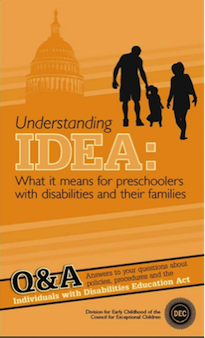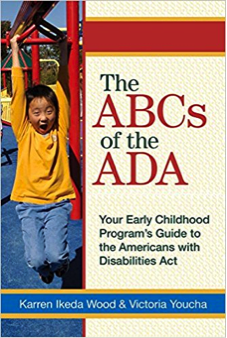5 Tips for Early Childhood Inclusion
There are many benefits to including children with disabilities in typical preschools and child care centers, including:
Young children have opportunities to learn from and share experiences with each other. This includes positive models for learning, communication and behaviors.
All children feel a sense of belonging.
Children of all ages learn to appreciate diversity in others.
When everyone participates, children have opportunities to be creative, resourceful and cooperative (ICCC, 2017)
We know that the National Association for the Education of Young Children (NAEYC) and the Division for Early Childhood (DEC) support and promote the inclusion of children with disabilities within early childhood settings as evidenced by their 2009 Position Paper on Early Childhood Inclusion.
However early childhood teachers,
and other professionals, are sometimes unsure
about how to include children with disabilities
within their programs.
Here are five tips to help to promote successful early childhood inclusion in your classrooms:
Tip #1: Be Welcoming!

Think about how you welcome children and families into your early childhood school and/or classroom. A positive greeting each morning can make the difference in a great day for that child or a challenging day in the classroom for all involved. When you greet a child and a family, they feel welcomed and feel like they belong as part of your community.
Take a look at your admissions and registration procedures for your program. Are these policies inclusive to all children and families? Consider your website and who families speak to when they call your program. How can you be even more welcoming to all families, including families of children with disabilities and delays? Do you talk about inclusion and/or children with disabilities in your online website, written brochures, and handbooks?
Check out the Oregon Inclusive Child Care Program. ICCP works directly with parents, child care providers, and community partners to offer training and help with supports and accommodations in child care.
Welcoming and including children with disabilities
physically into your program is only the first step, however…
Tip #2: Use a Strengths-Based Approach

Know the children in your class!
Children with disabilities,
just like typically-developing children,
have special interests and strengths.
For example, John the preschooler pictured above loves to play with blocks and cars. By building what you know about John’s strengths, you can more effectively work on his weaker areas—perhaps vocabulary and oral language skills. You might bring two peers into John’s block play during free choice time and have conversations about what they are each building, improving and increasing oral language skills and vocabulary for all three children.
Tip #3: Know the Laws
There are two main laws that affect BOTH public and private preschools and child care centers: the Individuals with Disabilities Education Act (IDEA) and the Americans with Disabilities Act (ADA).
As an early childhood professional,
you want to familiarize yourself with these laws
to ensure that the choices you make as a classroom teacher
or as a program administrator are not only good for the child,
but also following legal mandates.
Two excellent books to help you learn more about special education laws and early childhood centers are:
The ABCs of the ADA: Your Early Childhood Program’s Guide to the Americans with Disabilities Act by Karren Ikeda Wood and Yictoria Youcha
Understanding IDEA: What it Means for Preschoolers with Disabilities and their Families by Sharon Walsh and Ross Taylor
Tip #4: Collaborate with Families

Families of children with disabilities and delays need lots of communication.
Families need to be heard,
and they need to hear from you as their child’s teacher.
In order to meet these needs you, as the early childhood professional, need to develop a way that works personally to meet increased communication. Some programs use a communication notebook, with the teacher and family writing notes to each other back and forth weekly or more frequently. Some programs schedule more parent-teacher conferences with families of children with disabilities and delays to check in and monitor progress.
Sharing a child’s strengths and opportunities for growth are both important to communicate with a family. Documenting and recording a child’s interests and activities are essential for the early childhood teacher to collect through an ongoing record keeping system.
The more upfront time you spend building relationships with families, the better relationship you will have when it comes to talking about difficult topics like evaluations and delays in development.
Want to build your skills in collaborating with families of children with disabilities? Take this free online module on family engagement from the Virtual Lab School.
Tip #5: Partner with other Professionals

Did you know that there are free supportive services for young children with disabilities starting at birth?
You, as an early childhood education professional,
do not have to do this alone!
If you, and/or a family member, is concerned about a child’s development you can call your county contact to schedule a free screening and evaluation.
If a disability is diagnosed, the child may receive supportive services in your classroom, ranging from occupational therapy to speech and language pathology to physical therapy. Collaborating with these other professionals, and their expertise, will help you better meet the needs of the child with disabilities in your classroom.
So now you have your homework!
Let’s work together to support children with disabilities and their families in our early childhood programs across Oregon and beyond.
I did then what I knew how to do. Now that I know better, I do better.
-Maya Angelou
Resources:
http://oregoninclusivecc.org/about-inclusion/benefits-of-inclusive-child-care/
https://www.naeyc.org/sites/default/files/globally-shared/downloads/PDFs/resources/position-statements/DEC_NAEYC_EC_updatedKS.pdf
http://oregoninclusivecc.org/what-we-do/
http://www.ncte.org/library/NCTEFiles/StrengthsBased.pdf
https://www.amazon.com/ABCs-ADA-Childhood-Americans-Disabilities/dp/1557669333
http://bookstore.dec-sped.org/product-p/002.htm
https://www.virtuallabschool.org/preschool/family-engagement/lesson-4
http://www.ode.state.or.us/gradelevel/pre_k/eiecse/dyhcfinalenglish.pdf


































